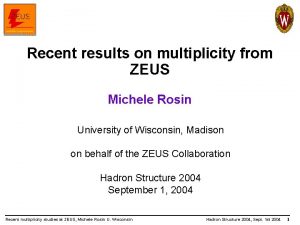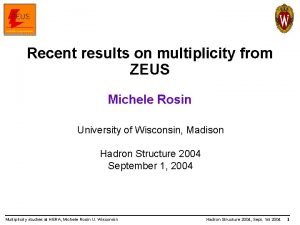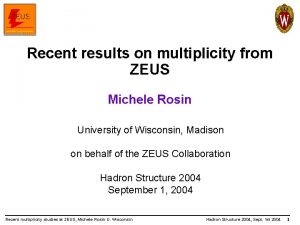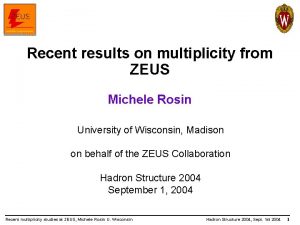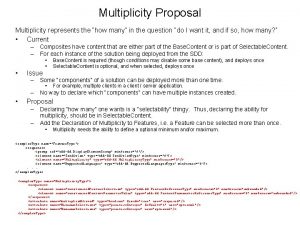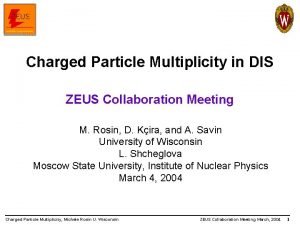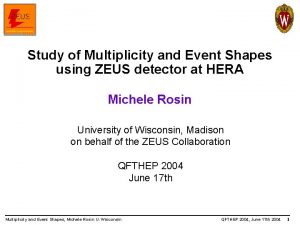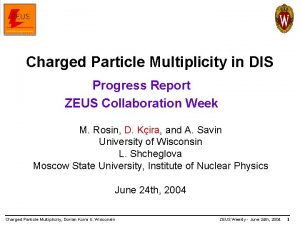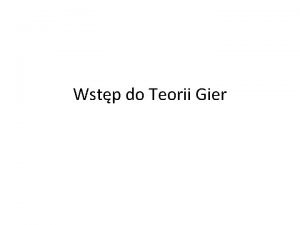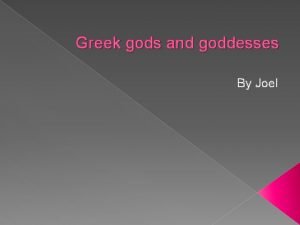Recent results on multiplicity from ZEUS Michele Rosin

















- Slides: 17

Recent results on multiplicity from ZEUS Michele Rosin University of Wisconsin, Madison on behalf of the ZEUS Collaboration Hadron Structure 2004 September 1, 2004 Recent multiplicity studies at ZEUS, Michele Rosin U. Wisconsin Hadron Structure 2004, Sept. 1 st 2004 1

HERA description & DIS kinematics • 920 Ge. V p+ (820 Ge. V before 1998) • 27. 5 Ge. V e- or e+ • 318 Ge. V cms (300 Ge. V) • Equivalent to a 50 Te. V Fixed Target DESY Hamburg, Germany H 1 ZEUS • DIS Kinematics: e(k) (q) e’(k’) remnant p(P) q’ Virtuality of photon Recent multiplicity studies at ZEUS, Michele Rosin U. Wisconsin Inelasticity 0 ≤ y ≤ 1 Fraction of p momentum carried by struck parton Hadron Structure 2004, Sept. 1 st 2004 2

e+e- & ep : Breit Frame Lab Frame DIS event · Breit Frame definition: · “Brick wall frame” incoming quark scatters off photon and returns along same axis. ·Current region of Breit Frame is analogous to e+e-. PT Recent multiplicity studies at ZEUS, Michele Rosin U. Wisconsin PL Hadron Structure 2004, Sept. 1 st 2004 3

Measurement vs. Q · Consistent with e+e- data for high Q 2 ·Disagreement at low Q 2 may be attributed to gluon radiation ·Idea of current analysis: Understand current and target multiplicity and compare to e+e- European Physics Journal C 11 (1999) 251 -270 Recent multiplicity studies at ZEUS, Michele Rosin U. Wisconsin Hadron Structure 2004, Sept. 1 st 2004 4

Multiplicity: ep vs. e+e- (1) ·e+e-: boson with virtuality √s produces 2 quarks & hadronization is between 2 colored objects q and q ·ep: boson with virtuality Q produces 1 quark: the 2 nd quark comes from the interaction between the photon and the proton ·current region of Breit frame for ep similar to one hemisphere of e+e- Recent multiplicity studies at ZEUS, Michele Rosin U. Wisconsin Hadron Structure 2004, Sept. 1 st 2004 5

Multiplicity: ep vs. e+e- (2) ·ep: Split into Current and Target Region – one string two segments. ·In ep we have a color field between 2 colored objects the struck quark and the proton remnant ·When we use Q 2 as a scale we are assuming the configuration is as symmetric as it is in e+e-, but it isn’t ·This asymmetric configuration leads to migration of particles from the current region to the target region Breit Frame diagram Recent multiplicity studies at ZEUS, Michele Rosin U. Wisconsin Hadron Structure 2004, Sept. 1 st 2004 6

Gluon radiation, Q, and 2*EBreit Soft Contribution q Hard Contribution q q q g g QCD Compton ·In hard and soft processes gluon radiation occurs ·These gluons can migrate to target region ·Total energy in the current region of Breit frame and multiplicity are decreased due to these migrations (Q 2 is not) ·Effect is more pronounced for low Q 2 : more low energy gluons ·Must use 2*EBreit and 2*Nch for comparing with e+e. No migrations: Recent multiplicity studies at ZEUS, Michele Rosin U. Wisconsin N < N expected With migrations: Hadron Structure 2004, Sept. 1 st 2004 7

<nch> vs. 2*Ecurrent · Measurement of multiplicity dependence on 2*Ecurrent compared to previous ZEUS measurement vs. Q · 2*E gives better description of multiplicity at lower energy ·This approximation of invariant mass partially takes into account the real distribution of the particles. ·Lepto prediction slightly above Ariadne ·Current region understood, would like to use some energy scale to compare target region for ep to e+e-. . Recent multiplicity studies at ZEUS, Michele Rosin U. Wisconsin Hadron Structure 2004, Sept. 1 st 2004 8

Visible multiplicity in Breit and hadronic center of mass (HCM) frames Visible Part ·Breit Frame: 90% of hadrons in current region visible in detector, only 30% of target region hadrons are visible ·Need some other way to investigate these particles All Hadrons Current Region Breit Frame Proton remnant Recent multiplicity studies at ZEUS, Michele Rosin U. Wisconsin Hadron Structure 2004, Sept. 1 st 2004 9

Hadronic center of mass frame Ecms E =W E p g Nphoton region Nproton region Ecms/2 Nphoton region vs W Recent multiplicity studies at ZEUS, Michele Rosin U. Wisconsin Hadron Structure 2004, Sept. 1 st 2004 10

Visible multiplicity in Breit and hadronic center of mass (HCM) frames ·HCM Frame: We see a bigger number of particle in the detector than in the current region of the Breit frame ·Photon region dominated by contribution from target region of Breit frame (~80% of visible hadrons) ·Proton region unseen in detector · Using HCM is intuitive because all interactions in e+eand pp happen in center of mass frame Recent multiplicity studies at ZEUS, Michele Rosin U. Wisconsin Visible Part All Hadrons Current Region Breit Frame Proton remnant Visible Part All Hadrons Photon Region HCM Frame Proton Region HCM Frame Hadron Structure 2004, Sept. 1 st 2004 11

Multiplicity vs. W in HCM ·Measurement of Multiplicity in photon region of HCM frame vs. W. ·Lepto prediction slightly above that for Ariadne. ·Interesting to multiply the multiplicity measured in both the current region of the Breit frame and the photon region of the HCM frame by 2 (there are 2 hemispheres) and compare to e+e- Recent multiplicity studies at ZEUS, Michele Rosin U. Wisconsin Hadron Structure 2004, Sept. 1 st 2004 12

Multiplicity in current region of Breit and HCM frames compared to e+e- and pp ·Measurements in current region of Breit frame and photon region of HCM frame multiplied by 2. ·There is agreement with e+eat low and high energy and with the pp results which are plotted vs. a scale that takes into account the leading particles. ·Would also like to make a measurement vs. invariant mass, where we measure visible multiplicity and plot it vs. visible energy less model dependence. Recent multiplicity studies at ZEUS, Michele Rosin U. Wisconsin Hadron Structure 2004, Sept. 1 st 2004 13

Charged Hadrons & Effective Mass: experimental method ·Measure hadronic final state within for best acceptance in the central tracking detector (CTD) ·Measure # charged tracks, reconstruct number of charged hadrons ·Measure invariant mass of the system (Meff) in corresponding delta eta region. ·Energy is measured in the Calorimeter (CAL) Study: <nch> vs. Meff CTD CAL within the CTD acceptance Recent multiplicity studies at ZEUS, Michele Rosin U. Wisconsin Hadron Structure 2004, Sept. 1 st 2004 14

Lab frame: <nch> vs. Meff in x bins ·Lab frame multiplicity vs. Meff, shown in 4 xbins, with Ariadne predictions. · x range split into similar bins as in previous multiplicity paper. · weak x dependence in both data and MC observed. ·Q 2 dependence? => next page Recent multiplicity studies at ZEUS, Michele Rosin U. Wisconsin Hadron Structure 2004, Sept. 1 st 2004 15

Lab frame: x and Q 2 bins · Data described by ARIADNE · LEPTO slightly above data · No Q 2 dependence observed Recent multiplicity studies at ZEUS, Michele Rosin U. Wisconsin Hadron Structure 2004, Sept. 1 st 2004 16

Summary ·The mean charged multiplicity has been investigated in DIS ep scattering ·Measurement in current region of the Breit frame show similar dependence to e+e- if 2*Ecurrent is used as the scale, the same dependence is obs for the pho reg of hcm fra vs W. ·The mean ch multi in the lab frame has been also meas vs. inv mass of resp hadronic system. There is a weak x depen, and almost no Q dep were observed. Recent multiplicity studies at ZEUS, Michele Rosin U. Wisconsin Hadron Structure 2004, Sept. 1 st 2004 17
 Jamie rosin
Jamie rosin Eventbreit
Eventbreit A friend emails you the results
A friend emails you the results Recent demographic changes in the uk
Recent demographic changes in the uk Recent trends in ic engine
Recent trends in ic engine Passive voice news headlines
Passive voice news headlines Recent advances in dental ceramics
Recent advances in dental ceramics Explain the recent trends of india's foreign trade
Explain the recent trends of india's foreign trade Https drive google com drive u 0 recent
Https drive google com drive u 0 recent Myips.schoology.com
Myips.schoology.com Recent developments in ict
Recent developments in ict Https drive google com drive u 0 recent
Https drive google com drive u 0 recent Skimming techniques include
Skimming techniques include Biotaphonomy
Biotaphonomy Recent developments in object detection
Recent developments in object detection Udin login
Udin login Recent trends in project management
Recent trends in project management Jose has just played a long bruising football game
Jose has just played a long bruising football game

